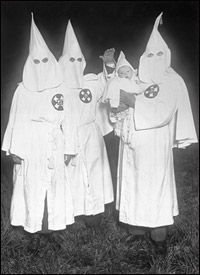Revisiting the Ku Klux Klan
Three histories of the Invisible Empire provide insights into America's oldest terrorist group. They are written from the perspectives of a clinical psychologist, a scholar, and a professional writer.
Over the 142 years since it was born in Pulaski, Tenn., much has been written about the Ku Klux Klan and its history of terrorism. Americans' fascination with the hooded order seems inexhaustible — punch "Klan" into the book search engine of the Amazon.com website, and you'll pull up a staggering 22,767 results.
But there is a huge variety of literature within the Klan genre, and not all of it is good, accurate or even particularly interesting. Some of the work is unreliable; in other cases, it is tendentious and ideologically driven. Much of it simply repeats the pioneering work of scholars like David Chalmers, author of Hooded Americanism: The History of the Ku Klux Klan, probably the definitive history of the Klan.
What follows are very brief reviews of three useful books about the Klan. The first is an overall history that includes much material not covered by Chalmers and other earlier writers; the second tells the story of the "second era" Klan of the 1920s in American cities; and the third focuses in on the Klan's activities in Florida, a state with a history of severe racial oppression. They are written, respectively, from the perspectives of a clinical psychologist, a scholar, and a professional writer.
The Fiery Cross: The Ku Klux Klan in America
By Wyn Craig Wade
New York: Oxford University Press, 1998
$21.50 (hardback)
Originally published in 1987, Wyn Craig Wade's book is a highly readable account of most of the Klan's history, from Reconstruction through the 1980s. Although it is heavier with anecdote than analysis, it is rich with colorful accounts of such events as the 1915 screening of the pro-Klan "Birth of a Nation" in the White House — a publicity coup that helped catapult Klan membership to as many as 4 million people.
The book is also replete with detailed descriptions of Klan leaders and key activists. It is particularly good in describing the remarkable collapse of the 1920s Klan in the wake of several major scandals, especially the conviction of Indiana state leader D.C. Stephenson in a brutal rape-murder. And it does something few Klan histories do in offering a thorough recounting of the New Deal and post-World War II era, when the organization was weak but still managing to function.
Wade's book also covers Klan terrorism during the civil rights movement — violence that actually helped propel the passage of key civil rights legislation — and carries that story forward to 1987. It discusses the rise of the David Duke Klan, the 1979 Klan massacre in Greensboro, N.C., and a number of leaders who are still with us today, as well as some of their opponents. And it includes a series of fascinating Klan documents, some laying out secret Klan rituals, in appendices.
The Ku Klux Klan in the City, 1915-1930
By Kenneth T. Jackson
Chicago: Elephant Paperbacks, 1992
$18.90 (paperback)
In the august language of academic reviews, Kenneth Jackson's unusual history of the "second era" Klan is "highly commendable," "a book to be respected." But that doesn't quite cover it. Jackson works hard and effectively to debunk the argument that the 1920s Klan, which railed against Catholics and other immigrants, was primarily a rural reaction to the urbanization of America. He shows that the Klan of that period instead was basically an urban phenomenon, a reactionary response to immigrants then flooding mainly into Northern cities.
The book, first published in 1967, also debunks the idea that the Klan was immensely successful in most of the states where it grew so rapidly in the 1922-25 period. In fact, the Invisible Empire had to fight pitched battles with established politicians and newspapers in cities as diverse as Chicago, Detroit, Portland and Denver. Jackson also recounts the little-remembered but key tactic pursued in many cities against the Klan — publication of secret membership lists that resulted in highly effective boycotts of businesses owned by Klansmen. For those who oppose the Klan today, the book offers an enlightening account of how their forebears took on the hooded order.
The Invisible Empire: The Ku Klux Klan in Florida
By Michael Newton
Gainesville: University of Florida, 2001
$24.95 (hardback)
Authored by the man who, with his wife, wrote an invaluable but out-of-print encyclopedia of the Klan, this book is a pleasure for anyone with an interest in the radical right in Florida. It is well written, filled with important material about Klan influence on lawmen and politicians, and rife with detailed descriptions of terror.
The book covers some 130 years of Klan history in Florida, but it also includes important material about some of the other radical right leaders who interacted with the Klan. When it gets to the late 20th century, it describes how the Klan in Florida made alliances with neo-Nazis and even, in the 1990s, with a violent wing of the anti-abortion "right to life" movement.
Newton ends his book on this worrying note, variations of which can be found in Jackson and Wade's prose, too: "The Klans endure today because their prejudice still finds an audience and echoes with disturbing resonance. That message is the dark side of America, the nightmare lurking in the shadow of the dream."




